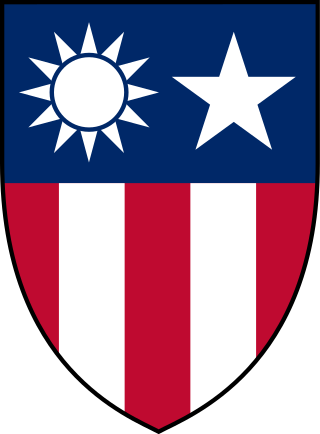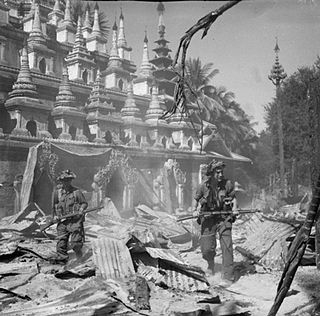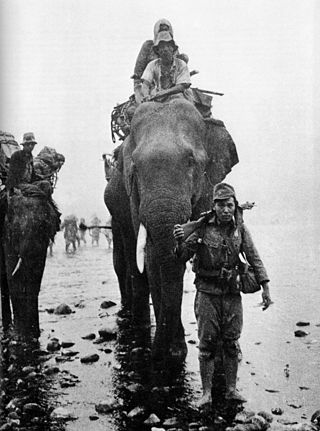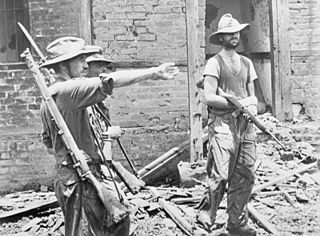
Joseph Warren "Vinegar Joe" Stilwell was a United States Army general who served in the China Burma India Theater during World War II. An early American popular hero of the war for leading a column walking out of Burma pursued by the victorious Imperial Japanese Armed Forces, his implacable demands for units debilitated by disease to be sent into heavy combat resulted in Merrill's Marauders becoming disenchanted with him. Infuriated by the 1944 fall of Changsha to a Japanese offensive, Stilwell threatened Chinese Nationalist leader Chiang Kai-shek that lend-lease aid to China would be cut off, which led Ambassador Patrick J. Hurley to decide Stilwell had to be replaced. Chiang had been intent on keeping lend-lease supplies to fight the Chinese Communist Party, but Stilwell had been obeying his instructions to get the CCP and the Kuomintang to co-operate against Japan.

The Chindits, officially as Long Range Penetration Groups, were special operations units of the British and Indian armies which saw action in 1943–1944 during the Burma Campaign of World War II.
The 11th Army Group was the main British Army force in Southeast Asia during the Second World War. Although a nominally British formation, it also included large numbers of troops and formations from the British Indian Army and from British African colonies, and also Nationalist Chinese and United States units.

Merrill’s Marauders (named after Frank Merrill) or Unit Galahad, officially named the 5307th Composite Unit (Provisional), was a United States Army long range penetration special operations jungle warfare unit, which fought in the Southeast Asian theater of World War II, or China-Burma-India Theater (CBI). The unit became famous for its deep-penetration missions behind Japanese lines, often engaging Japanese forces superior in number.

The Northern Combat Area Command (NCAC) was a subcommand of the Allied South East Asia Command (SEAC) during World War II. It controlled Allied ground operations in northern Burma. For most of its existence, NCAC was commanded by United States Army General Joseph "Vinegar Joe" Stilwell. In 1945 after Stilwell was recalled, his deputy, Lieutenant General Daniel Sultan, was promoted to and assumed command.

South East Asia Command (SEAC) was the body set up to be in overall charge of Allied operations in the South-East Asian Theatre during the Second World War.

The Burma campaign was a series of battles fought in the British colony of Burma. It was part of the South-East Asian theatre of World War II and primarily involved forces of the Allies against the invading forces of the Empire of Japan. Imperial Japan was supported by the Thai Phayap Army, as well as two collaborationist independence movements and armies. The first of these was the Burma Independence Army, which spearheaded the initial attacks against the country. The Indian National Army, led by Subhas C. Bose of the Free India movement, also collaborated with Imperial Japan, especially during Operation U-Go in 1944. Nominally independent puppet states were established in the conquered areas and some territories were annexed by Thailand. In 1942 and 1943, the international Allied force in British India launched several failed offensives to retake lost territories. Fighting intensified in 1944, and British Empire forces peaked at around 1 million land and air forces. These forces were drawn primarily from British India, with British Army forces, 100,000 East and West African colonial troops, and smaller numbers of land and air forces from several other Dominions and Colonies. These additional forces allowed the Allied recapture of Burma in 1945.

China Burma India Theater (CBI) was the United States military designation during World War II for the China and Southeast Asian or India–Burma (IBT) theaters. Operational command of Allied forces in the CBI was officially the responsibility of the Supreme Commanders for South East Asia or China. However, US forces in practice were usually overseen by General Joseph Stilwell, the Deputy Allied Commander in China; the term "CBI" was significant in logistical, material and personnel matters; it was and is commonly used within the US for these theaters.

The Ledo Road was an overland connection between India and China, built during World War II to enable the Western Allies to deliver supplies to China and aid the war effort against Japan. After the Japanese cut off the Burma Road in 1942 an alternative was required, hence the construction of the Ledo Road. It was renamed the Stilwell Road, after General Joseph Stilwell of the U.S. Army, in early 1945 at the suggestion of Chiang Kai-shek. It passes through the Burmese towns of Shingbwiyang, Myitkyina and Bhamo in Kachin state. Of the 1,726 kilometres (1,072 mi) long road, 1,033 kilometres (642 mi) are in Burma and 632 kilometres (393 mi) in China with the remainder in India. The road had the Ledo-Pangsau Pass-Tanai (Danai)-Myitkyina--Bhamo-Mansi-Namhkam-Kunming route.

X Force was the name given to the portion of the National Revolutionary Army's Chinese Expeditionary Force that retreated from Burma into India in 1942. Chiang Kai-shek sent troops into Burma from Yunnan in 1942 to assist the British in holding back the Japanese. These Chinese forces became broken up, and in the retreat out of Burma part of these forces entered India. These were cantoned at Ramgarh Cantonment in the Bihar Province, brought up to five-Division strength, and re-equipped and re-trained by American instructors at British expense.

Fort Hertz was a remote British Military outpost in northeastern Burma in the district of Putao in what is now the Kachin State near the present town of Putao. It was named after William Axel Hertz. Hertz led the first expeditions into the far north of Burma in 1888, was responsible for the 1912 Gazetteer of Kachin Hills area and served as the first Deputy Commissioner of the Government in the Putao District. The military post was established in 1914 and given the name Fort Hertz in 1925 on the retirement of William Hertz from the Indian Civil Service.

The 36th Indian Infantry Division was an infantry division of the Indian Army during the Second World War. The division was subsequently redesignated as a British Army formation, the 36th Infantry Division in September 1944. It served in India and during the Burma Campaign. After the end of the war it was disbanded and its remaining British units were transferred to the British 2nd Infantry Division.

Battle of Northern Burma and Western Yunnan was the name of the Chinese campaign with their allies in the 1943–45 Burma Campaign. The campaign ended in an Allied victory.

The Chinese Expeditionary Force was an expeditionary unit of China's National Revolutionary Army that was dispatched to Burma and India in support of the Allied efforts against the Imperial Japanese Army during the Japanese invasion and occupation of Burma in the South-East Asian theatre of the Second World War.

The fighting in the Burma campaign in 1944 was among the most severe in the South-East Asian Theatre of World War II. It took place along the borders between Burma and India, and Burma and China, and involved the British Commonwealth, Chinese and United States forces, against the forces of Imperial Japan and the Indian National Army. British Commonwealth land forces were drawn primarily from the United Kingdom, British India and Africa.

The Burma campaign in the South-East Asian Theatre of World War II was fought primarily by British Commonwealth, Chinese and United States forces against the forces of Imperial Japan, who were assisted by the Burmese National Army, the Indian National Army, and to some degree by Thailand. The British Commonwealth land forces were drawn primarily from the United Kingdom, British India and Africa.

The Japanese 33rd Army was an army of the Imperial Japanese Army during the final days of World War II.

The Taping River, known as Ta Hkaw Hka in Kachin and Daying River in Chinese, is a river in Yunnan province, China and northern Myanmar (Burma). It is the first tributary of the country's chief river, the Irrawaddy, and the watersheds between it and the N'mai Hka river to the northwest and the rivers Shweli and Salween to the southeast form part of the boundary between China and Myanmar. Its source lies in Yingjiang County of Yunnan, and it enters the Irrawaddy near Bhamo, Kachin State.

The siege of Myitkyina was an engagement during the Burma campaign of World War II. The Allied victory was part of the larger Battle of Northern Burma and Western Yunnan which succeeded in opening the Ledo Road.

The Battle of Mogaung was a series of engagements that was fought in the Burma Campaign of World War II between 6 and 26 June 1944 at the Burmese town of Mogaung. In brutal fighting, the 77th 'Chindit' Brigade under Brigadier Michael Calvert, later assisted by Chinese forces of Generalissimo Chiang Kai-shek, fought for and captured the town from the occupying forces of Imperial Japan.



















